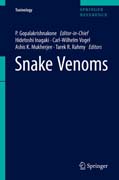
Snake Venoms
Gopalakrishnakone, P.
Inagaki, Hidetoshi
Vogel, Carl-Wilhelm
Mukherjee, Ashis K.
Rahmy, Tarek R.
Initially, because of the inadequate sensitivity of devices and other limitations, only major venom components of the dominant species were studied. However, in last two decades, increased sensitivity of devices and the development of new techniques, such as transcriptomics and proteomics techniques, have permitted us to analyze the structures and functions of rare species and to identify novel minor components. As a result, the number of venom components identified is increasing dramatically and the physiological functions of each component is more deeply understood. The scope of this book provides the readers an updated and comprehensive presentation on snake venoms. The subjects are divided into six sections, starting with the overview of snake venom compositions in Malaysian species, followed by description of enzymes and enzyme inhibitors contained in snake venoms. Also discussed are the effects of snake venom on cellular receptors, ion channels, blood, and lymph, as well as cytotoxic and antimicrobial molecules present in snake venoms. The last section covers the clinical consequences of envenomation and the management of snakebites using antivenins.
- ISBN: 978-94-007-6410-1
- Editorial: Springer
- Encuadernacion: Rústica
- Páginas: 497
- Fecha Publicación: 14/12/2016
- Nº Volúmenes: 1
- Idioma: Inglés
